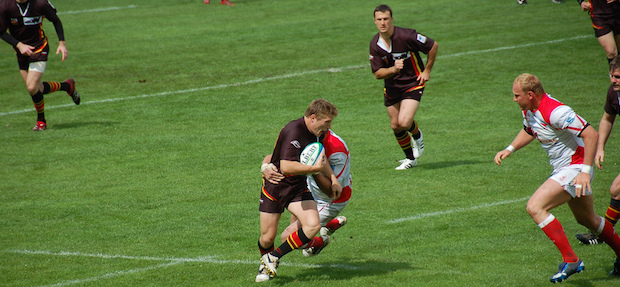
With the start of the Rugby World Cup just days away, it’s a great time to carry on with our rugby injuries series. The Physiotherapy Partners have treated a wide range of sports players, and helped them along their road to recovery.
The shoulder is one of the most commonly injured joints in rugby. The shoulder has an amazing range of motion and the most mobile joint in the body but can be injured easily. Rugby injuries involving the shoulder are likely to occur from suffering from a blow after a tackle or a fall. Unfortunately, all injuries involving the shoulder joint increase the risk of recurrent injuries so it is essential you seek professional guidance and treatment when suffering from any shoulder injuries, sports related or not. This is something The Physiotherapy Partners are more than happy to guide you through from any one of our three Midlands clinics.
The forceful impact of a rugby tackle, for example, can lead to bones being pulled out of place, which is what a dislocated shoulder is classified as, while a shoulder subluxation is when the upper arm joint is only partially pulled out of the socket. Immediate medical attention is needed when a patient suffers either injury. Symptoms of a dislocated shoulder include a visibly dislocated or out of place shoulder, being unable to move the shoulder joint, numbness in the area or swelling as well pain of the shoulder. The severity of a dislocated shoulder depends on the individual, and the worse case scenario may involve surgery.
If surgery is not needed, a dislocated shoulder is diagnosed by a physiotherapist examining your shoulder, looking in particular for signs of instability. X-rays may also be needed to identify any other problems or to confirm the diagnosis. No matter if surgery is needed or not, rehabilitation involving physiotherapy is essential for recovery. Here at The Physiotherapy Partners we tailor your treatment plan to your specific shoulder injury, and recovery time is dependent on the individual case.
The first phase of recovery is similar to most recovery processes and involves pain relief, minimising swelling and injury protection. Managing pain is an important step to move forward and recover. Overstretching the injured tissues should really be avoided for around the first two to six weeks. It is also likely you will be provided with a shoulder sling to support your shoulder. Inflammation of the area is managed with ice therapy, and your physiotherapist may introduce to other treatment tools to reduce pain if they believe it is necessary. It is vital to maintain shoulder strength, in terms of your shoulder blade and rotator cuff muscles, during the next phase of recovery. Your physiotherapist will also prescribe tailored exercises for your needs and assess your muscle recruitment pattern.
The third stage of recovery is to restore your normal joint range of motion, muscle length, tissue mobility and resting muscle tension. Your physiotherapist will assist you with treatment, such as joint mobilisation and alignment techniques, massage, muscle stretches or acupuncture, if they feel it is needed. Your treatment plan will be tailored to what is best for you at this stage. The next stage of recovery is about restoring full function, returning you back to your everyday activities. Individual situations and demands on the shoulder will help your physiotherapist to identify specific treatment goals. After recovery has been achieved, your physiotherapist will help to educate your muscles to work together, by means of connected control, and make the brain aware of your shoulder control, to aid prevention of recurring shoulder injuries.
If you are suffering from a shoulder injury, or are in need of our expertise in any other way, please contact us and book an appointment at one of your three clinics.
Photo credit: Krzysztof Belczyński via Flickr cc



